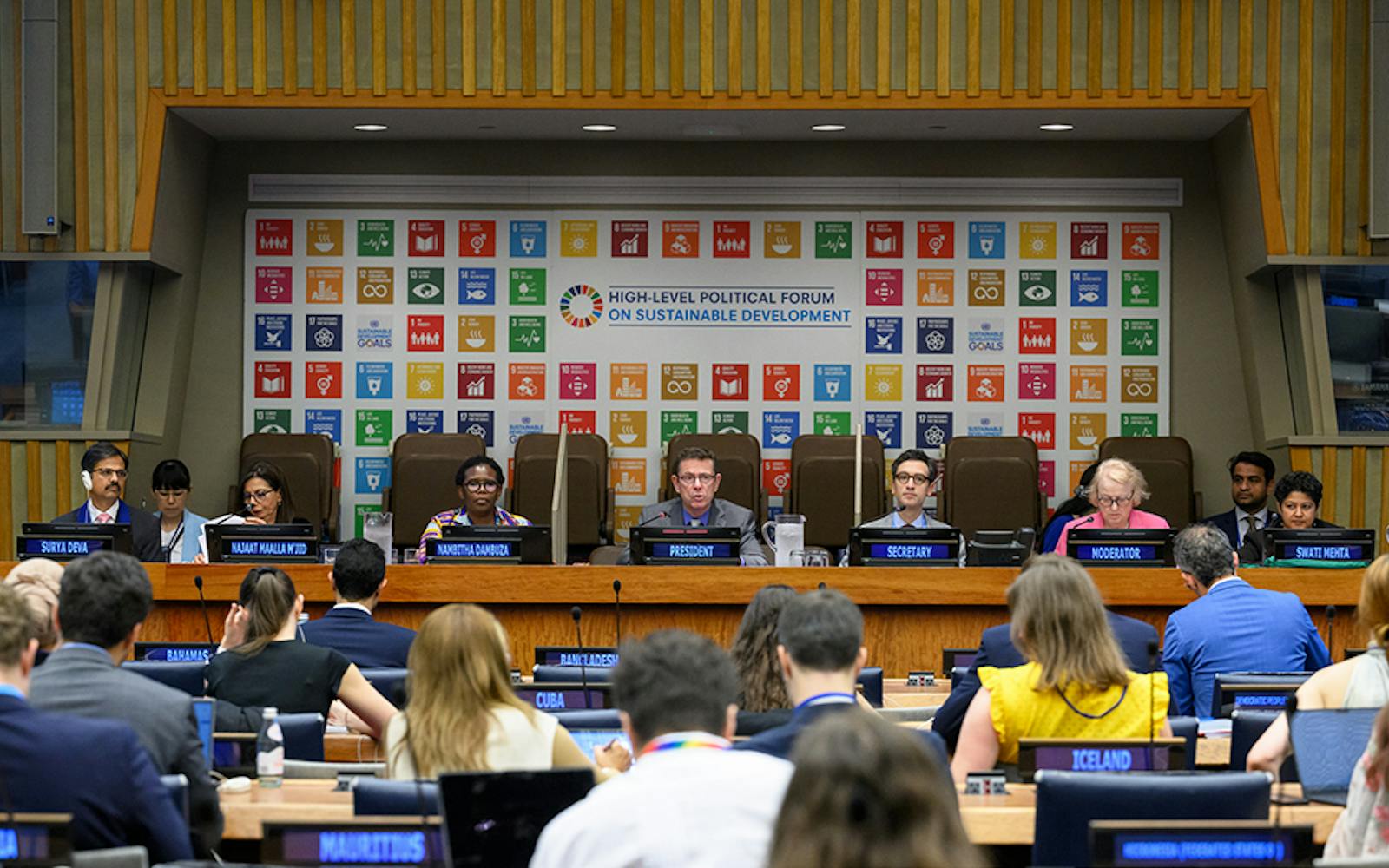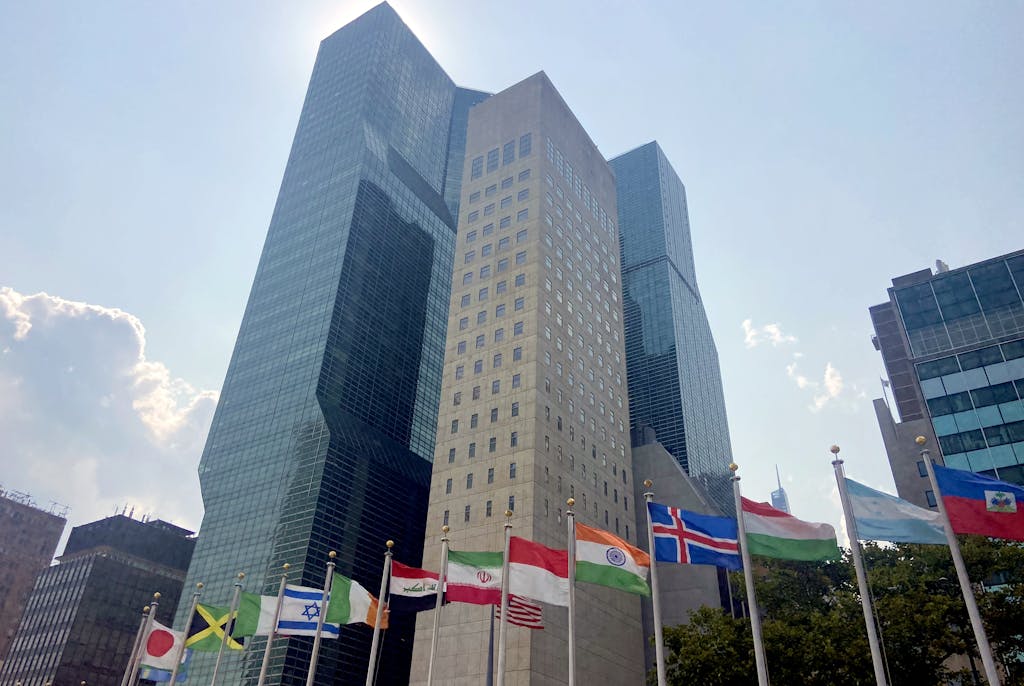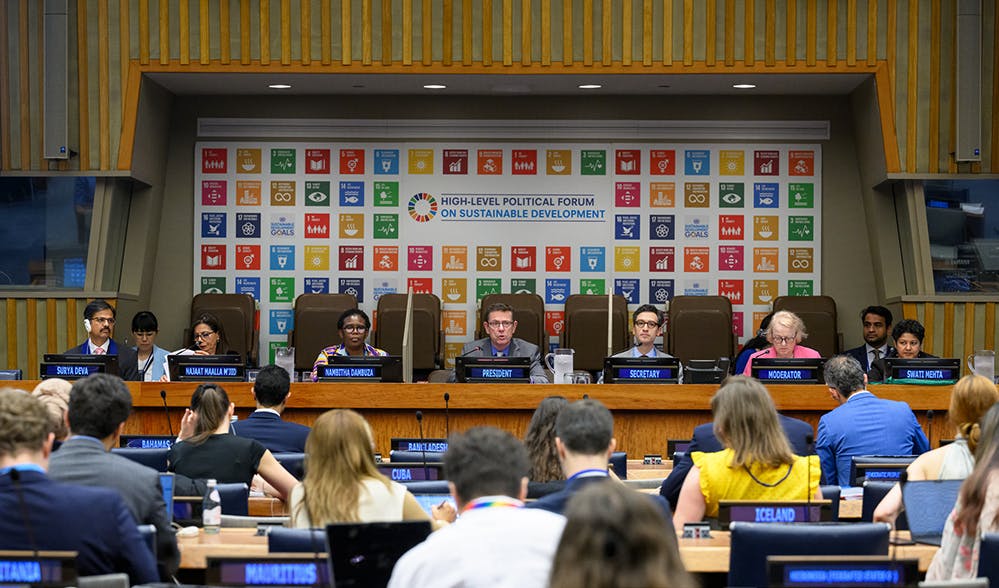

Ivan Šimonović, Vice-President of the UN’s Economic and Social Council leads a meeting on SDG 16: Peace, Justice, and Strong Institutions during the 2024 High-level Political Forum on Sustainable Development. Photo: UN Photo/Loey Felipe
Justice is more than an ideal. The Global Goal of Peace, Justice, and Strong Institutions is a prerequisite for progress and a mutually reinforcing framework. All other 16 Sustainable Development Goals rely on its achievement. To build effective, accountable, and inclusive institutions at all levels, governments and global stakeholders are scaling up people-centered approaches to justice — advancing SDG 16, and by extension, the entire 2030 Agenda.
The Genesis of SDG 16
The adoption of Global Goal 16 — Peace, Justice, and Strong Institutions — was a hard-earned effort. It marked the first time that promoting the rule of law, expanding access to justice for all, and making institutions more accountable and transparent were universally recognized as a global path to peace with development targets.
“Most of the other goals had controversial elements, but Goal 16 was the only goal that many delegates didn’t think belonged in the framework at all,” said Elizabeth Cousens, President and CEO of the United Nations Foundation, in remarks delivered at an SDG 16 event on the sidelines of the High-Level Political Forum on Sustainable Development 2024 (HLPF) at the United States Mission to the UN.
Over a decade ago, Cousens was among the diplomats and world leaders who negotiated the 17 Sustainable Development Goals (SDGs) and their 169 targets, including SDG 16: Peace, Justice, and Strong Institutions. Negotiations on the Goals spanned two years before they were ultimately agreed upon by all 193 UN Member States in 2015.
It was challenging. “There were countries in the middle of their own peace processes that were worried that an agreement on some of these goals would tie their hands in peace negotiations,” Cousens said. “So there was a huge spectrum that ranged from apprehension to downright opposition, and it was very fierce.”
But thanks to the leadership of Liberia, Sierra Leone, Timor-Leste, and countries across Central America in particular — which insisted that peace was essential for development — building support for SDG 16 became possible. External factors such as investments from Nordic countries and the United Kingdom, as well as the partnership between the United States, the U.S. Department of Justice, and the UN further solidified the legitimacy of SDG 16 on the global agenda.
For these reasons and more, SDG 16 “was potentially the most transformative goal in the entire framework because it goes to the very heart of policies, practices, norms, and institutions that create fair and safe conditions for people to advocate and advance their own rights and interests and needs,” said Cousens.

The Global Progress Report on SDG 16 Indicators affirms that access to justice, which encompasses both civil and criminal justice, is a fundamental human right. The data presented in the report further reveals the lack of progress on target 16.3. Photo: Courtesy of UNDP-UNHCR-UNODC: Global Progress Report on SDG16-Indicators
SDG 16 Now: Numbers in Context
Today, rising conflicts, violent organized crime, and geopolitical issues persist worldwide, according to the Sustainable Development Goals Report 2024. These global events exacerbate suffering, hinder sustainable development, and serve to widen the gap for access to justice, despite it being a fundamental human right.
The SDG 2024 report puts some of the statistics around justice — or lack of justice — into perspective. For example, the global prison population increased from 11.1 million in 2015 to 11.5 million in 2022. A third of that global prison population — 3.5 million people — was held in pretrial detention or had not yet been sentenced. With government budgets strained by a confluence of factors from political instability to inflation and volatile global prices, the ability to swiftly administer justice is severely affected.
This distressing data underscores that the path to global peace and security, which is key to sustainable development, has been complex — and must change. It’s why SDG 16 and all its targets are pivotal to reversing these trends.
SDG 16 in Action Across the U.S.
Conversations around momentum for SDG 16 continued via forums at the UN coinciding with HLPF. The event spotlighted people-centered solutions and approaches that governments and stakeholders are taking to advance implementation of SDG 16. Keynote speeches drew upon President Joe Biden’s Memorandum on Access to Justice and U.S. rule of law commitments undertaken through the Summit for Democracy. With Goal 16 as one of five Goals under review at HLPF this year, the dialogue was paramount in promoting the connection between access to justice and the promise to leave no one behind — both in the U.S. and beyond — which is at the heart of the 2030 Agenda.
“Far too many individuals, are simply not able to access justice in the United States and around the world. In these grand halls, with sweeping views, surrounded by governments with expansive goals set forth by an impressive Sustainable Development Agenda, it can be easy to forget the people that this work is for,” said Rachel Rossi, Access to Justice Director at the U.S. Department of Justice, in her welcome remarks for the event titled, Turning the Tide: Scaling SDG 16 for the Future, Reinforcing Access to Justice, and Advancing Democracy. “But the Founding United Nations Charter reminds us that the peoples of the United Nations determined, reaffirmed faith, and fundamental to the rights and the dignity and worth of the human person … SDG 16 is more than an agenda item. It is a tool to facilitate action to directly impact people, ensuring that the promises of economic security and equal justice are within reach for everyone.”

The United States Mission to the United Nations hosted a meeting on the implementation of SDG 16 with the U.S. Office for Access to Justice on the sidelines of the 2024 High-level Political Forum on Sustainable Development. Photo: Dynahlee Padilla-Vasquez
Leveraging SDG 16 Knowledge
At the United States Mission to the UN, the Office for Access to Justice convened local, federal, and global stakeholders, civil society, and academics to share and deepen knowledge on peace, justice, and strong institutions. The primary focus was on SDG 16.3: to promote the rule of law at the national and international levels and ensure equal access to justice for all.
“I am just very excited to see that we’re here 10 years on, to see this effort by the Department of Justice to connect leaders and experts together to tackle access to justice gaps, which unfortunately … are growing rather than shrinking in the United States, and to share insights and genuinely learn together domestically and the broader global community,” said Cousens.
The gathering exemplified a groundswell of support for the SDGs across the U.S., demonstrated by the people who came together from diverse backgrounds and specialties. In convenings about how the SDGs and access to justice show up in their everyday work, participants echoed the need to advance support for justice workers, expand civil justice advocacy, and increase the number of justice defenders. Recommendations to bring in tangible tools to further shape policy, such as increasing financing to invest in access to justice, providing quality access to counsel in civil and criminal courts, and expanding access in rural areas and legal deserts, resonated.
Far too many people are missing from the conversation. And representatives of groups attending the gathering stressed that systems and institutions working to close gaps in access to justice must meet people where they are. Specifically, that means inviting more people to the conversation on justice, including people in law enforcement and prisons as well as prosecutors, chief justices, young people, Indigenous communities, community justice groups, and non-lawyers with justice experience.

Jhody Polk, founder of New York University’s School of Law Jailhouse Lawyers Initiative (JLI) and Darren Breeden, a Community Justice Fellow at JLI, helped a community member navigate the justice system after being falsely accused of a crime. Photo: Courtesy of Jhody Polk
Jhody Polk, founder of NYU’s School of Law Jailhouse Lawyers Initiative (JLI) and a formerly incarcerated jailhouse lawyer from Florida, agrees. “Community justice must be a process, not a program — a process that identifies how a community is isolated and then brings community into community ownership,” she said. “Community justice, at its core, has to have processes that allow the community to hold institutions to account when they cause harm.”
Community justice “starts with the people who have the privilege to know and understand what law and justice are,” adds Darren Breeden, Community Justice Fellow at JLI. “To give it away, go into the community, college, and classrooms, and make sure potential law students move with this understanding. Once people have knowledge of the law, then we can empower people to use it in a way that’s shaping the law … to help their own lives.”
SDG 16 Implementation: Next Steps for a More Just Future
As the Office for Access to Justice underscored, this dialogue is just the start. SDG 16 will continue to be a framework to make peace and justice possible everywhere as they’re fundamental to all 16 other goals. The 2030 Agenda for Sustainable Development is a shared blueprint for peace and prosperity, and SDG 16 is paramount. Not only does this Global Goal align with broader human rights issues and social and economic development, but promoting peace and justice secures our future and that of generations to come.
“For me, peace and justice are interrelated. We cannot have peace without justice,” said Veronica “Derek” Valdez Cabe, Coordinator of the Nuclear and Coal-Free Bataan Movement in the Philippines.
Join the Movement
A newly launched microsite serves as a people-centered hub for anyone who wants to learn more about American leadership toward the Sustainable Development Goals, SDG 16 specifically, and the entire framework. To dive deeper, check out the UNDP’s Global Progress Report on SDG 16 Indicators.

